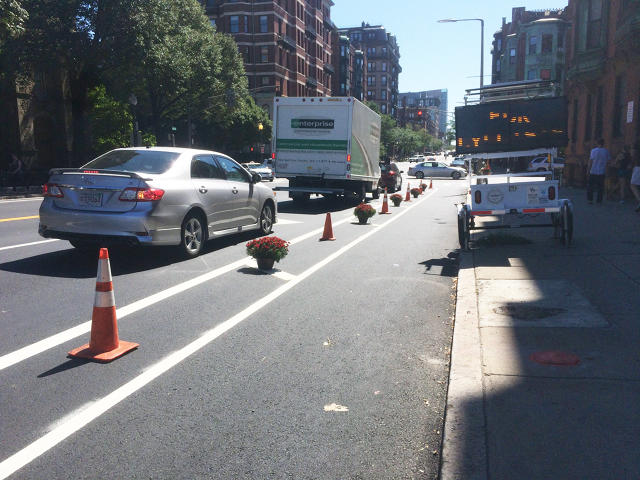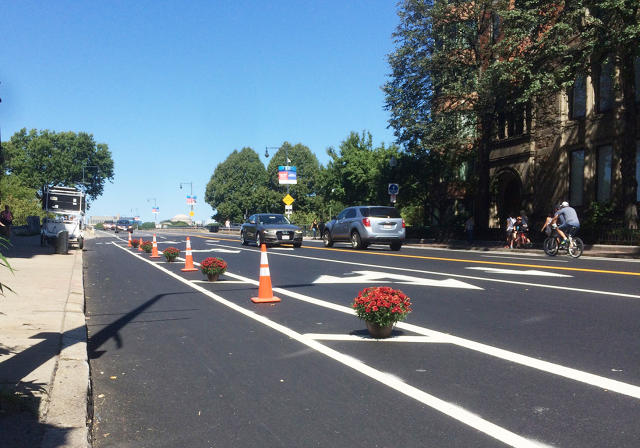One thing worth fighting is good design. When it comes to sidewalks and bikelanes, if there is an intrinsic flaw in the design, it can be dangerous, little used, expensive and permanent.
Consider sidewalks built directly next to high speed roads without any green buffer.
 |
| See the difference? |
Understandably, the later project, with the green buffer, is likely more expensive but with the permanency of such projects and the cost involved, shouldn't our goal be to build the better designed project so that people actually use it?
***
I like this guys take on a similar problem.
A Guerrilla Bike Lane Made With Flower Pots Forces A City's Hand
A cyclist in Boston was sick of a dangerous stretch of road that the city refused to fix, so he took on the matter himself.
For Boston cyclists, Massachusetts Avenue can be a terrifying place to ride—drivers routinely ignore the stripes marking the bike lane and swerve into the path of bikes. After a truck driver recently killed one young bike commuter, the city promised to add some simple barriers to the lane. But they were slow to act.
So another bike commuter decided to take on the problem himself: On his way to work in Harvard Square, Jonathan Fertig dropped off a line of orange construction cones and potted flowers along the edge of the bike lane.
"I've been growing increasingly frustrated over the past year," says Fertig, who saw progress on bike infrastructure in the city start to slow when a new mayor came into office.

"When a young woman was killed by a truck driver last month while riding the route that I ride every day it hit me in an unexpectedly personal way," he says. "I was searching for a way that I could do something to amplify to fury that many of us in the walking and cycling advocacy community were feeling."
He picked up a copy of Tactical Urbanism, a book that lays out urban interventions like DIY bike lanes. Inspired, he "just decided to drop some cones in the buffer of the newly installed bike lane. In an instant, cars were no longer using the bike lane as a turning lane."

The flowers have a symbolic connection to the memorial at the corner, where a ghost bike has a flower-filled basket. "Flowers are also beautiful and entirely non-confrontational in their own right," Fertig says. "I liked the concept of using them in an act of civil disobedience. ... I am a child of hippies, after all."
The intervention worked—at least for a small stretch of the road. "It's a joy for 200 feet, until you reach the corner where the terror resumes," he says. "I've had countless people tell me online that the intervention made a big difference."

Less than a week after he installed the cones and flowers, the city came out to add flexible posts (they still have yet to paint the lane green or add green bike boxes, two other promises the transportation department made). But Fertig, like many other cyclists in the area, thinks the lane could be much safer—and probably should be fully separated with a permanent barrier.
He also wanted to draw attention to how slow the city was to act. "While re-engineering the intersection in any capacity within a month would typically be considered a very quick response, they only did so because of the fatality, and it was thus reactionary," he says. "The city—and the advocates that helped crunch the data—have known for two years that the intersection has one of the highest crash rates for cyclists and pedestrians in the whole city, yet they had done nothing."
As a continuing protest, he added more flowers to the new flexible posts.
He's also raising money to add more interventions down Massachusetts Avenue—which he calls the most dangerous stretch of road in the city. In the first two days, the campaign raised more than $3,000.
LINK:

No comments:
Post a Comment